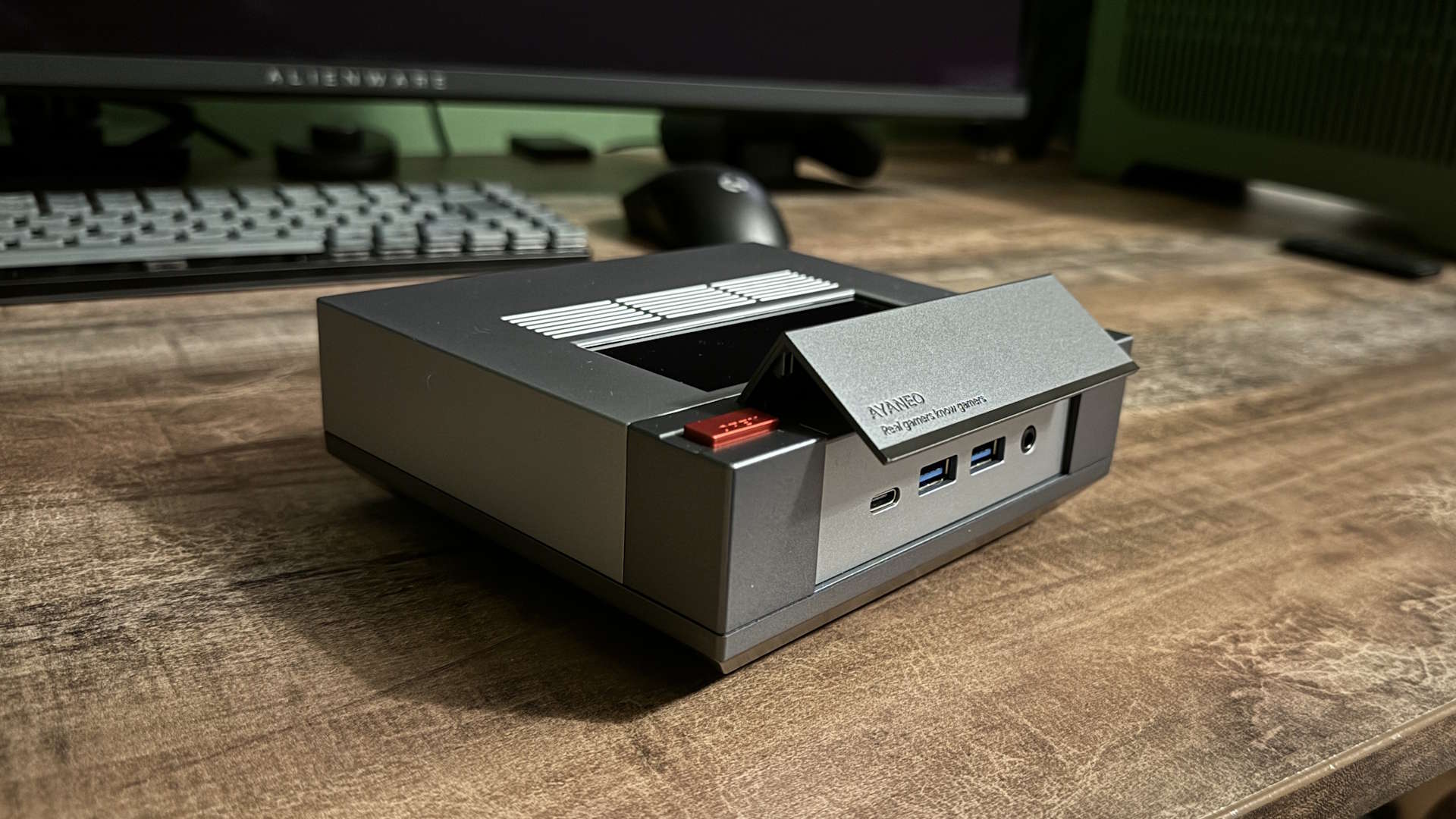
A gorgeous little retro-themed PC that is right at home playing retro and indie games on your TV.
In a world where PC gaming hardware is dominated by a handful of behemoths, whose foghorn message of “GET OUR STUFF, CRUSH YOUR FOES” is expressed in some truly awful product aesthetics, I’m just super-happy to see a manufacturer like Ayaneo treading a different path.
It specialises in handheld gaming PCs (such as the Ayaneo Kun and the Air 1S), built around AMD’s low-power, performant APUs, but dabbles in mini-PCs as well. The Retro Mini AM02 is its second such release, and it’s cute as a button.
It’s a pint-sized homage to the original Nintendo Entertainment System, complete with a front hood which pops open to reveal twin USB 2.3 ports, a USB4 Type-C, and a combined audio socket. It’s elegant, tactile, easy on the eye, and once you have it installed on your desk (or by your TV, we’ll come to that), I defy you not to throw admiring glances at it from time to time.
The styling of the Retro Mini AM02 goes hand-in-hand with the capabilities of the machine. It says “Make an emulator out of me! PLAY ALL THE GAMES YOU GREW UP WITH!”, which you absolutely can, you absolutely should—I absolutely did—but that doesn’t preclude the fact that the hardware is capable of more.
(Image credit: Future)
APU: AMD Ryzen 7 7840HS
iGPU: Radeon 780M
Memory: 0GB | 32GB | 64GB DDR5-5600MHz
Storage: 0TB | 512GB | 1TB
Wireless: Wi-Fi 6E, Bluetooth 5.3
I/O: 2x USB 4/Thunderbolt, 3.5mm audio, 4x USB 2.3, 2.5G LAN, 2x HDMI 2.1
Price: $479 (Barebones), $599 (16GB+512GB), $639 (16GB+1TB), $699 (32GB+1TB)
Housing AMD’s Ryzen 7 7840HS, the higher-wattage version of the 7840U found in Ayaneo’s handhelds, and packing a Radeon 780M iGPU, most modern games should run playably at 1080P, provided you’re willing to sacrifice higher graphics settings.
There’s a 4-inch touchscreen on the lid which can be swiped left or right to display detailed system info, a clock, or a quick-access panel to switch between preset performance modes. It’s just begging for some custom wallpaper options, though the functionality isn’t there yet—Ayaneo is planning this for a future software update.
Round the back, you get twin 1 Gb and 2.5 Gb Ethernet ports, HDMI 2.0, DisplayPort 1.4, a pair of USB 2.0 ports, and a USB-C port reserved for the AM02’s power adapter. The kit also handles WiFi 6E and Bluetooth 5.2. In short, it’s all good on the specs front, though a second USB-C on the front would’ve been welcome.
The Retro Mini AM02 ships preinstalled with Ayaspace, Ayaneo’s hardware and game-library interface layer. Designed for their handhelds, it feels most at home with a gamepad. This implies a strong use-case for the Retro Mini as a dedicated micro-console to plug into your TV, and in that scenario, you can configure Ayaspace to run fullscreen at boot. It’s still an app running in Windows 11 of course, not an OS in its own right, and for more traditional desktop PC use, I set it to minimise to the system-tray at Windows boot and invoked it only when needed.
It can feel a little clunky and slow-to-act using a keyboard and mouse as your principle input devices—the UX has clearly been designed around gamepad controls first—but it works well enough. What I did notice in my time with the Retro Mini was several small technical and UI-improving updates to Ayaspace, which I would expect to continue.
(Image credit: Future)
(Image credit: Future)
(Image credit: Future)
(Image credit: Future)
The performance tab of Ayaspace is awash with tweakers. These toggles and sliders expose BIOS-level hardware settings, including the CPU’s TDP limit, sliders for the CPU and iGPU clock speeds, a CPU turbo toggle, a general power-policy setting, and automatic or custom fan-curves for the CPU cooler.
There are three presets out of the box: Power Saving (8 W TDP, potato mode, borderline fine for web browsing), Balanced (15 W TDP, good for emulation and simpler indies) and Extreme (28 W TDP, with less-than-full CPU and iGPU clockspeeds, but fine for less demanding titles). You can create custom presets too, though only the factory presets show up on the 4-inch touchscreen’s mode-switcher.
Obviously the first thing I did was to crank everything up; that TDP slider goes to 45 W after all. It’s possible to get some nice performance gains with custom presets, though whether those gains are marginal or appreciable is entirely title-dependant. I set up an ‘Overclock’ preset, with the TDP set to 45 W, the CPU and iGPU given free rein with their full clockspeed ranges, and the CPU Turbo option activated.
Bumping things up like this gets you a decent performance uptick. The best boost I saw was in Doom Eternal—which looks fabulous at 1080p with medium settings, by the way—and switching between the stock 28 W Extreme preset and my 45 W custom ‘Overclock’ preset, the frame rate jumped from around 60-70 fps to 70-90 fps playing the same section of the same level. Which was deeply gratifying, and speaks volumes for how enormously well-optimised Doom Eternal is. Just don’t expect those kind of gains in every game.
On paper, the Ryzen 7 7840HS can reach up to 54 W, but Ayaspace sets a max limit of 45 W. Similarly, the chip ought to boost to 5.1 GHz, but Ayaspace limits this to 4.7 GHz. We queried Ayaneo on this, and it responded by telling us the Retro mini is designed with specific size and thickness constraints, and that the limitation is in place to ensure effective cooling and optimal performance. Which makes sense; it is indeed a tiny box, and no doubt a challenge to cool.
It’s a tactic sometimes seen in the laptop space to keep temps down and preserve battery life, though the latter is clearly not a consideration here. So it’s a shame you can’t access the absolute top-end of the 7840HS’ capabilities, which some other manufacturers have achieved with their own proprietary cooling solutions.
(Image credit: Future)
(Image credit: Future)
✅ You want to build a gorgeous, TV-friendly emulation station: I mean, look at it. How cute is that wee thing?
✅ You play a lot of indies, and the odd heftier title: The AMD CPU, with its powerful integrated GPU, are perfectly capable of playing both indie classics and modern games at a decent pace.
❌ You want the most powerful mini PC there is: There are certainly micro machines that get more out of very similar silicon.
❌ You’re looking for completely silent operation: It can definitely get a little ‘chatty’ when its fans crank up should you start making that AMD CPU run a little harder.
In terms of modern game performance, and if we’re considering a 30+ fps as playable, the Retro Mini gives a decent account of itself. Cyberpunk at 1080P with Ultra settings, FSR2 set to auto and no Ray Tracing runs nicely at 52 fps. Total War: Warhammer 3’s campaign map is rather more bruising, netting only 25 fps at 1080P/medium/28 W, though this rises to a more comfortable 30 fps when we bump up the TDP to 45 W and crank the clock speeds. Forza Motorsport was slick, smooth and enjoyable at 45 W, but It’s difficult to recommend Homeworld 3 on hardware of this category; despite the tested average of around 40 fps, you’re beset with frequent, jagged 1% lows.
We also ran a handful of indies and older games at 1080p/medium/45 W, to get a feel for the sort of frame rate-ranges you can expect across different games. None of the following have built-in benchmarks, so we’ve kept them off the official table, but hopefully they’ll give you a flavour of the Retro Mini’s wider capabilities. Subnautica was eminently playable around the 50-60 fps mark, Stray sat comfortably in the 45-60 fps range, Soulstone Survivors got 90 fps which dropped to a still-highly-palatable 45 fps during peak pyrotechnics, Still Wakes the Deep managed 60-70 fps, and Bioshock Remastered capered along at a frankly hilarious 130-200 fps.
Setting it up as an emulator was a doddle using the free and fantastically user-friendly Emudeck, and in no time I had my favourite games of yesteryear populating my Steam library, flawlessly playable on the TV using an Xbox Elite gamepad. And I think that’s just glorious. I mean sure, any old PC can be set up as an emulator in the same way. But when you turn the Retro Mini AM02 into a living-room retro console emulator, everything falls into place, and you get the sense it’s fulfilling its destiny.






